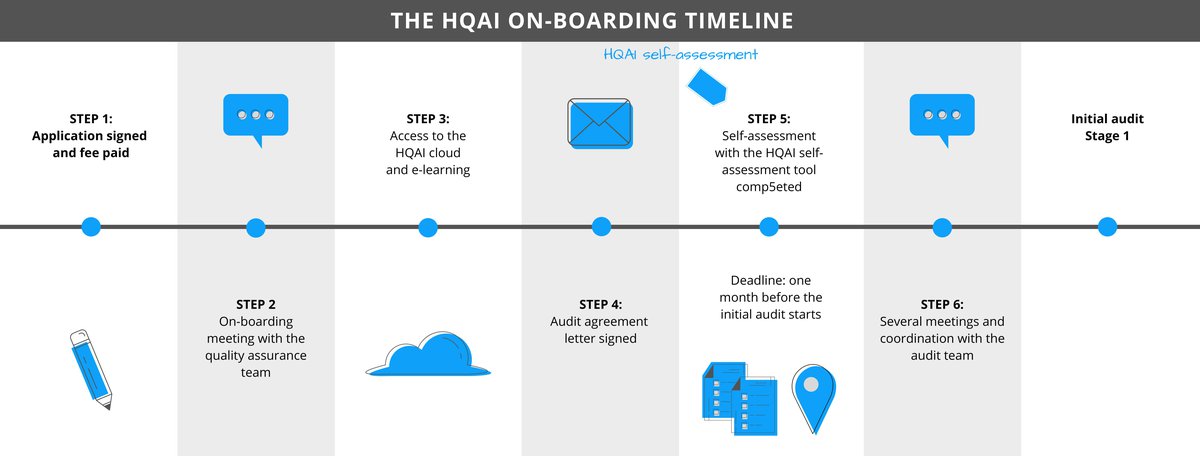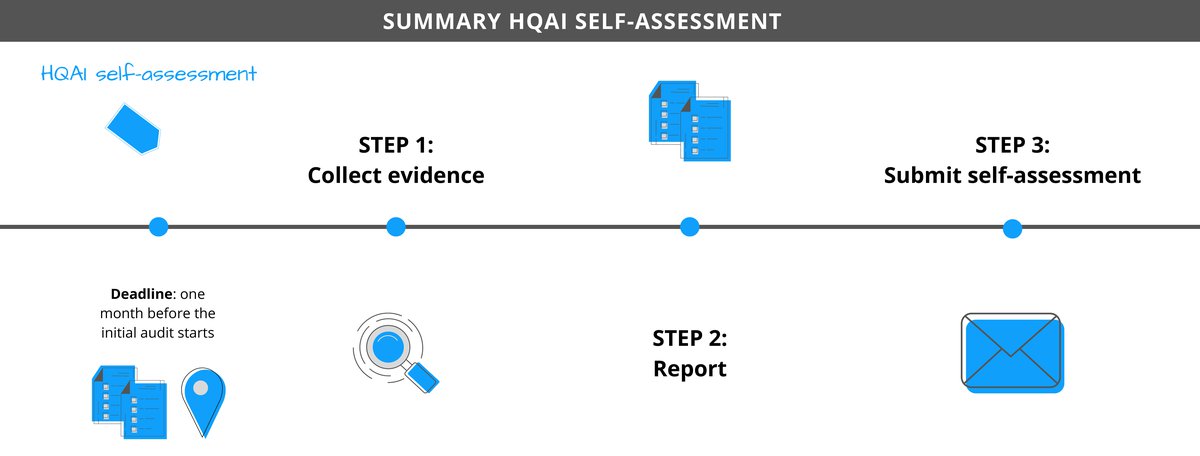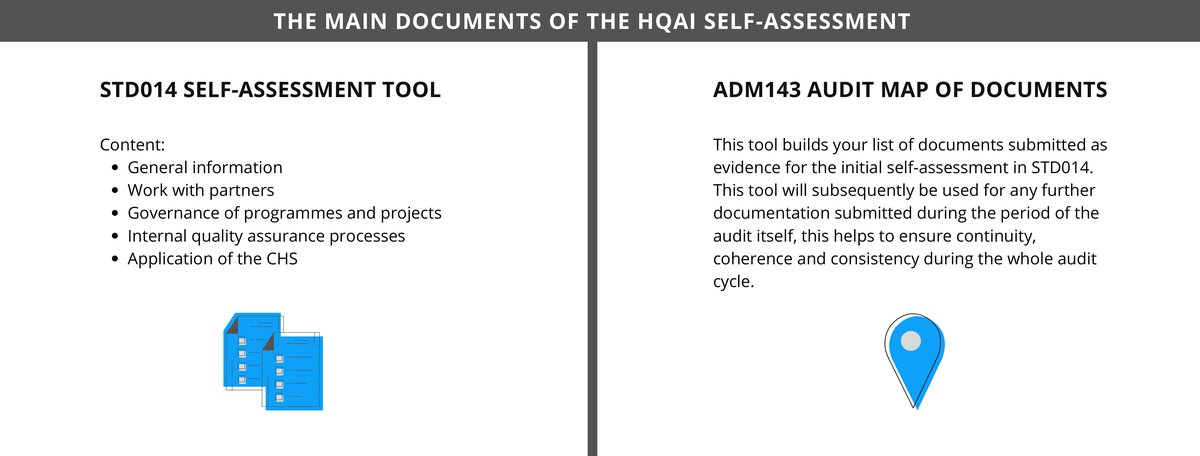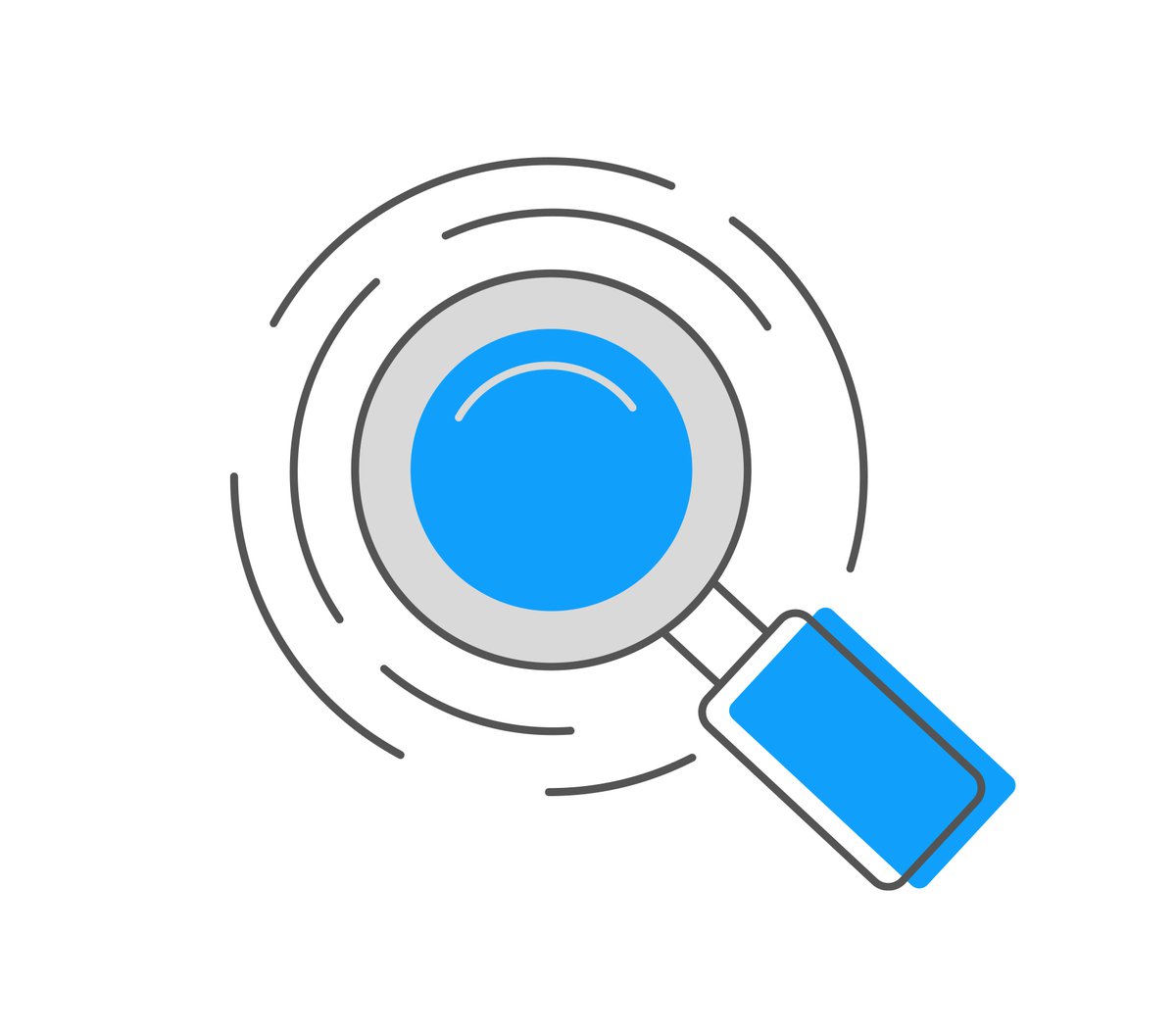The HQAI self-assessment
The HQAI self-assessment
The HQAI self-assessment is used as a preliminary step in an initial audit for each independent quality assurance process. Whether benchmarking, independent verification or certification, the HQAI self-assessment has to be completed before the actual audit starts and provides the auditor team with a useful overview of the organisation. It supports the collection of information at Head office and policy level.
Here is an overview where the HQAI self-assessment sits in the on-boarding process:

Be aware!
Some organisations may have already completed a CHS Alliance self-assessment as part of their membership responsibilities. The self-assessment for the CHS Alliance and for HQAI are broadly similar but have somewhat different purposes.
For the CHS Alliance it is a stand-alone process, while for HQAI, the self-assessment is a specific step in the auditing process (see above step 5). The HQAI self-assessment purpose is about gathering information and evidence that is specifically required at this stage of the audit process.
Please note that if your organisation has conducted a self-assessment using the CHS Alliance tool you can submit this to HQAI in place of the HQAI self-assessment, providing it was completed within the past 12 months. No additional work is required.
Here is a summary of all steps in the HQAI self-assessment:

Important documents of the HQAI self-assessment tool:
The main documents to complete the HQAI self-assessment are the STD104 Self-Assessment Tool and ADM143 Audit Map of Documents.
Before you start, please read the GUI125 Self-Assessment Manual and GUI12 6 Information Management Guidelines. The latter provides orientation on how to collect the relevant information. Both documents help you to make your self-assessment process efficient.
The quality assurance team will provide you with the necessary documents.
Overview of documents:
ADM143 Audit Map of Documents
GUI125 Self-Assessment Manual
GUI126 Information Management Guidelines


STEP 1: COLLECT EVIDENCE
Focus on two elements during your self-assessment:
- Internal policies and procedures of the organisation relevant to the CHS 9 commitments. This level of evaluation is the first step and can lead to informative data on the management system of your organisation.
- Internal mechanisms for compliance and quality control. Whether systems are effectively implemented and have the capacity to control and/or improve practice is largely dependent on the quality of internal controls and quality assurance mechanisms.
For most organisations, information on internal systems can be provided by policies and procedures on governance, human resources, monitoring and evaluation, risk analysis, internal audit, programme design frameworks, etc.
Below you will find more information in regards to the scope of the HQAI self-assessment and the process.
The scope
The HQAI self-assessment is primarily a document review at head office and policy levels. There is no need to travel to country programmes. The self-assessment enables auditors to gain a perspective on how the organisation assesses itself in terms of its application of the requirements of the CHS and the extent to which policies, processes and systems deliver on its requirements.
The mapping of audit documents makes the entire audit process more efficient.
The process
The team:
Some organisations use internal staff and others use an external consultant to complete the self-assessment. Regardless of who does it, it should be objective and carried out in a way that ensures good cross-organisational engagement; this will help ensure a comprehensive perspective on organisational performance against the standard.
One person should take over the lead with a team at hand from different departments of your organisation.
Required information:
Let us clarify one term that is key to fill in the self-assessment. We ask you to collect evidence to support your self-assessment. Evidence is any information that demonstrates compliance with a requirement of the standard.
The evidence to support your compliance with the Organisational Responsibilities in the CHS can be found in your organisation's policies, manuals, guidelines and procedures.
The evidence linked to your compliance with the Key Actions (= or organisational practices) of the CHS can be found in reports, project proposals, evaluations, visual materials, minutes of meetings, monitoring reports, assessment, and many more.
It is important to read GUI126 Information Management Guidelines before you start the self-assessment to know how to collect information.
Further, one piece of evidence, e.g. a policy document, often provides evidence for multiple requirements of the CHS. Creating the list of key documents using ADM143 Audit Map of Documents is helpful in keeping track of your evidence and of the requirements to which each document relates, it also helps to avoid unnecessary duplication of documents. As each document is given a unique number this will facilitate cross-referencing in your report.
The timeline:
Deadline to submit the HQAI self-assessment is one month BEFORE the initial audit stage 1 starts. The initial audit cannot begin until the self-assessment and accompanying documents are submitted.
Work with partners:
The CHS is clear about work with partners:
“Organisations working in partnerships should explain their commitment to the CHS, seek understanding of how their partners approach the Nine Commitments and do whatever they can to work with them to implement the CHS commitments.”

Keep in mind that you assess your organisation and NOT your partner.
If your organisation is committed to the CHS, it has the responsibility to make sure it has put in place adequate mechanisms to ensure that the CHS commitments are delivered to communities, even when working through partners. The mechanisms in place should allow your organisation to identify and address risks of failure to deliver on the CHS 9 commitments to communities. Policies and actions designed to minimise risks or to address identified weaknesses are a good way to demonstrate that the mechanisms work.
How to reflect this in the self-assessment?
You should reflect on the due diligence processes and mechanisms in place when working with a partner, examples are:
- how it assesses the capacities of the partner to deliver each CHS commitment;
- how it assesses the extent to which the CHS requirements are delivered to communities;
- how it identifies potential gaps and what happens when weaknesses are identified.
Organisations have specific mechanisms in place to select and work with partners, to monitor their work and overview what happens on project level; these may include partnership agreements, monitoring systems, joint decision-making processes, feedback systems for partners and communities involved in programmes, training plans for partners, and many others.
These systems should be described in the section "work with partners" and explain whether they are:
- robust;
- cover all the requirements of the CHS;
- are applied consistently.
Your description should be submitted with documentary evidence to demonstrate the robustness of these systems.

STEP 2: REPORT
The indicators for STD014 are derived from the CHS Key Actions and Organisational Responsibilities, they are combined for the self-assessment to facilitate the reporting process.
Compile the findings of the document review and summarise the findings and evidence in STD014 Self-Assessment tool. Do not forget to provide a score for the different indicators, based on the scoring grid (see below). You should always provide evidence to support your findings and fill in the AMD143 Audit Maps of Documents.
Scoring:
For each indicator, you should provide a score based on your evidence. HQAI uses the following scores for independent verification or certification:
Score 0: indicates a weakness that is so significant that the organisation is unable to meet the commitment.
This leads to:
- Independent verification: major weakness;
- Certification: major non-conformity, leading to a major corrective action request (CAR) – No certificate can be issued or immediate suspension of certificate.
Score 1: indicates a weakness that does not immediately compromise the integrity of the commitment but requires to be corrected to ensure the organisation can continuously deliver against it.
This leads to:
- Independent verification: minor weakness
- Certification: minor non-conformity, leading to a minor corrective action request (CAR).
Score 2: indicates an issue that deserves attention but does not currently compromise the conformity with the requirement.
This leads to:
- Independent verification and certification: observation.
Score 3: indicates full conformity with the requirement.
This leads to:
- Independent verification and certification: conformity.
Score 4: indicates an exemplary performance in the application of the requirement.

STEP 3: SUBMIT THE HQAI SELF-ASSESSMENT
After completing the self-assessment, review the information provided, and submit to HQAI.
If the self-assessment and accompanying documents are not received within the agreed timeframe, the audit may be delayed or even cancelled; this could have cost implications for your organisation.
